GALWAY - CASTLES
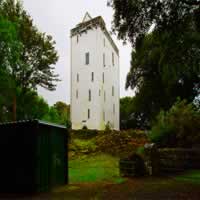
Ardamullivan Castle
near Derry, County Galway
Ardamullivan Castle is situated on a rocky outcrop surrounded by trees, about 5 miles south of Gort. The castle is a restored six storey tower house. Part of the original defensive wall remains. Ardamullivan Castle was built in the 16th century by the O`Shaughnessy family. In 1579, Dermot O`Shaughnessy and his nephew John fought each other in a dispute over the castle. The fight resulted in the death of both men. The castle fell into ruin and was restored in the last century.
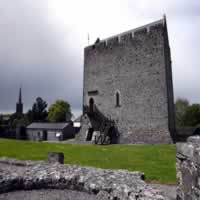
Athenry Castle
near Athenry and Kingsland, County Galway
The castle is situated in the center of the town of Athenry, 15 miles east of Galway. The castle Keep was built in 1253 by Meiler de Bermingham and after an attack in 1316 the large town wall were added. Not long after the completion of the walls, one of Ireland`s bloodiest battles was fought outside the town between the King of Connaught and the Normans. Until that time the area and castle were of great importance but the story changed after the battle. Meiler`s son raised the height of the first floor; he also embellished the entrance with a fine arched door at the south east end of the castle which was reached by a wooden staircase. During the reordering the banqueting hall was also enhanced with narrow trefoil headed windows; very rare in Irish castles. In the 15th century the tower was raised by two floors to include an attic and two gable ends and battlements were added. The basement only previously accessible by a trap door and ladder also benefited from having a new entrance. In 1596 the castle fell into the hands of the O`Donnell clan and never recovered from the great damage it sustained during the battle for its title and it wasn`t until the late 1980`s that the National Monuments branch of the Office of Public Works in Ireland started work on its restoration.
The castle offers guided tours during the summer but has no facilities for visitors. Opening hours April/May/October, Tuesday to Sunday 10 am - 5 pm, June to September daily from 10 am to 6 pm.

Aughanure Castle
near Lough Corrib, County Galway
Aughanure Castle is situated 2 miles from the village of Oughterard, on the banks of the Drimneed River close to the shores of Lough Corrib. Aughanure Castle was thought to have been built by the Walter de Burgo and was home to the O`Flaherty clan in the 15th century. The Aughanure Castle site comprises of a well preserved tower house and circular watchtower with its stone corbelled roof and the ruins of a watch tower, banqueting hall and gatehouse with drawbridge. The tower with battlements is six storeys high. A stone spiral staircase leads to the upper rooms; the uppermost room has a new oak timbered roof. From here you can access the battlements for a view across the lake and surrounding countryside. The main attraction of the castle is some of the elaborate stone carvings especially in the ruined banqueting hall, some of the soldier`s vantage points where they were able to attack unaware `visitors` and the hiding places where they used to incarcerate prisoners.
The castle is open daily between 09:30 am – 6 pm, April to September and during the rest of the year at weekends only. There are regular guided tours. The castle does not have its own restaurant but toilets are available for visitors.
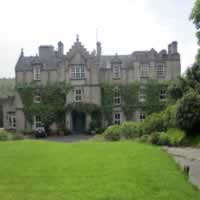
Ballynahinch Castle
Connemara Mountains, County Galway
Ballynahinch Castle is 41 miles west of Galway between Roundstone and Recess. It is set in 450 acres of private woodland overlooking the Twelve Bens mountain range and the river Ballynahinch. The appearance is more that of a crenellated Victorian mansion than a traditional castle. Made from honey colored stone it has 3 floors in the main building with the wings being only one or two floors. It is set in terraced gardens overlooking the river where fishing piers and the huts built in the 1920`s and can still be seen today. The castle built in the 1750`s was originally home to the `ferocious` O`Flaherty clan who lived there until the end of the century. One of the notable residents was the wife of clan member Donal O`Flaherty, Grace O`Malley also known as Pirate Grace as she was a pirate on the high seas. When her husband murdered by a rival clan she took over as the head of the O`Flaherty family a great honor for a woman.
Since 1946, Ballynahinch Castle has been used as a four star hotel offering salmon fishing, cycling, walking and game shooting. The hotel has 40 rooms, half in the older part of the castle with the more luxurious and superior rooms being situated in the two riverside wings.
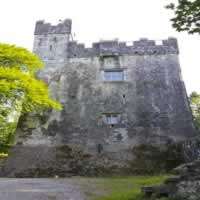
Dunsandle Castle & Woods
Kiltullagh, Athenry
Dunsandle Castle was first held by the De Burgo (Burke) family, acceded to the Daly`s and has recently been expertly restored. The castle is replete with unique architectural features which lead the visitor on a fascinating journey through history. Key features of the castle include a banqueting hall, an anti-clockwise spiral staircase, an oubliette (or secret chamber) and minstrel`s gallery. Also unique to Dunsandle is its groin vault construction, a Roman design feature that fell into relative obscurity in Europe until the resurgence of quality stone building brought about by Carolingian and Romanesque architecture. Dunsandle also contains an 18th-century Ice House in the castle grounds and Bawn (courtyard). Surrounded by 20 acres of native woodlands, pathways, picnic and playground areas allow visitors to explore and enjoy this natural heritage.

Dunguaire Castle
Kinvara, County Galway
Dunguaire castle is one of the most visited and photographed castles in the West of Ireland, conveniently located as it is, by the roadside on the way into the picturesque, seaside village of Kinvara. The castle was built by the Hynes clan in 1520, a family who may have been associated with the area since 662, when the site is believed to have once been the royal palace of Guaire Aidhne, the legendary king of Connacht and progenitor of the clan. Dunguaire Castle was transferred in the 17th century to Oliver Martin. It remained in his family until it was purchased in the early 20th century by the surgeon and poet Oliver St. John Gogarty. Gogarty began restoring the castle and established it as the meeting place for the leading figures of the Celtic Revival, such as W.B. Yeats, George Bernard Shaw, Lady Augusta Gregory and John Millington Synge. The castle was acquired in 1954 by Christobel Lady Ampthill, who completed the restoration work started by Gogarty. It was later purchased by Shannon Development. During the summer months when Dunguaire Castle is open to the public, a Medieval Banquet is held every night with costumed performers who recite Irish literature and play traditional Irish music.

Fidduan Castle
Tubber, County Galway
Fiddaun Castle is a tower house situated between Lough Doo and Lough Aslaun, near the village of Tubber, about five miles south west of Gort. Fiddaun Castle was built around 1574, and is one of three castles in the area owned by the O`Shaughnessy family. (The other O`Shaughnessy castles were Gort Castle, Ardamullivan Castle). Fiddaun guarded the western parts of the O`Shaughnessy lands. The most notable feature of this rectangular tower house is the remarkably well preserved inner bawn wall. The tower is a six storey structure with vaulted ceilings over the first and fifth floors, and an attic on the top floor. There are square box-shaped bartizans on the northern and southern corners at third floor level. The bawn is a rectangle with a three storey gatehouse in the north western wall, and a triangular point on the south west wall. The outer wall is now mostly in ruins, but at one time enclosed a massive twelve acres.
Fiddaun Castle is on private land and is now maintained by the Office of Public Works.
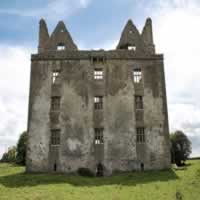
Glinsk Castle
Glinsk, County Galway
Glinsk Castle is situated in the River Suck valley about 4 miles south east of Ballymoe and 4 miles northwest of Creggs village. Glinsk Castle was one of the last defensive castles to be built in Ireland, and shows the architecture transition from traditional fortified castle to a residential castellated house. It as built as a fortified tower house around in the mid 17th century, and was the home of Sir Ulick Burke, the Baronet of Glinsk. The castle was destroyed by fire, and is now a well preserved ruin. The Castle is rectangular in plan with two square towers projecting from the southern side. It has three storeys and a raised basement. The main entrance way was on the first storey on the south side, between the two towers. The roof has gone, but was gabled with an attic. The interior walls and floors have gone. One of the most impressive features remaining is the prominent chimney stacks in the end walls. Each chimney stack has five tall shafts. The mullioned windows give the castle an elegant appearance more in keeping with a luxurious home than a traditional castle. Glinsk Castle did have defensive features such as gun loops, bartizans and high basements. The main door and the basement windows have gunloops at either side. It also used to have a surrounding defensive bawn wall with turrets, most of which has gone.
Glinsk Castle is accessible to the public, and a key may be obtained from the house near the castle. Access is signposted. The castle is now a National Monument. Also in the area you will find the ruins of Ballinakill Abbey, built in the early 1700s. There is a 60 mile long walking trail nearby along the River Suck valley.
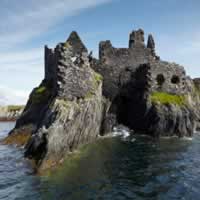
Oliver Cromwell`s Fort
Inishbofin, County Galway
Oliver Cromwell`s Fort is located on Inishbofin Island about 5 miles off the Connemara coast. The fort is a star-shaped fort perched on a rocky headland on Inishbofin Island, a relatively small island about 3.5 miles long and 2 miles wide. Cromwell`s Fort is at the entrance to the harbor. The fort was built in the 1650`s during Oliver Cromwell`s occupation of Ireland. Inishbofin was captured by Cromwell`s army and occupied by his troops until the end of the 17th century. Cromwell`s forces used the fort as a detention center for Catholic clergy and others who were waiting to be transported to the West Indies. After Cromwell`s rule ended and Charles II was restored to the throne in 1660, Cromwell`s Fort was used as a defensive structure. During the Jacobite War it was occupied by Irish Forces who held it until 1691, after which they surrendered to the Williamite Forces. The fort is now in ruins but much of the walls are standing, although some of the stonework has gone. The structure is about 120 feet by 80 feet with walls about 6 feet thick.
Inishbofin Island can be reached by ferry from Cleggan.
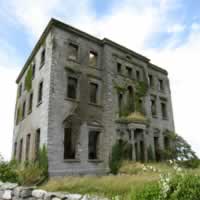
Tyrone House
near Kilcolgan, County Galway
Tyrone House stands on an outcrop by the sea, about two miles from Kilcolgan village. The structure is now a roofless and windowless ruin, made of blue-cut limestone, and stands three storeys high. The House was built in 1779. It was originally owned by Christopher St. George. It was the personal home of the family. The building was one of the largest homes in the country, with the property growing at one point in the 19th century to 53,000 acres. However, it was destroyed in 1920 by arson during the Irish War of Independence by the local IRA unit. It was never rebuilt, and remained in abandon until 1972, when the Irish Georgian Society acquired it. Wild ivy covers its walls; it stands high on rocky soil, its front facing south to the Atlantic, with the Kilcolgan River beyond the woods to the north. It is easily visible from all around.
Tyrone House can be viewed by the public from the outside. The house has commanding views over the surrounding Galway countryside.
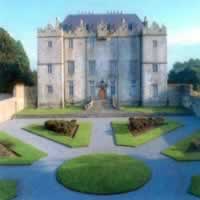
Portumna Castle & Gardens
Portumna, Co. Galway
Portumna Castle and Demesne occupy a magnificent location on the shores of Lough Derg on the River Shannon. Although gutted by fire in 1826, the Castle is still an imposing example of Irish architecture of the early 17th Century. Built before 1618 by Richard de Burgo, 4th Earl of Clanricarde, the castle became the main seat of the de Burgo family for over 200 years. Architecturally, the building marks the transition from the medieval Tower House to the Renaissance style manor house with complimentary influences from both periods. Following the fire and the ravages of time, the castle degenerated into a roofless shell. However, since 1968, the Office of Public Works re-roofed the building and based on extensive archaeological and historical research, other major conservation and partial restoration works continue to be carried out by a team of skilled craftsmen. The imposing façade of the castle faces north and is approached by a long avenue and formal gardens. The dramatic approach has three formal enclosures which contain geometric and regular plantings, an old shrub rose garden and a walled kitchen garden, all combining to re-create a sense of the original 17th century setting.
Opening Hours: 2nd April - 15th October; Daily 9:30 am to 6 pm.